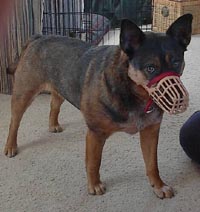Once
a dog has rendered a serious
bite to a human, and got what
it wanted as a result, it is
very difficult to ever be confident
that dog will never bite again.
At this point, it is time to
call an experienced dog behaviorist,
and still some cases end in
failure to correct this habit.
Therefore the key to preventing
euthanasia due to aggression
is to correct aggression early,
without resorting to violence
ourselves.
 The
most important next step is
to determine the CAUSE of the
aggression. If there
The
most important next step is
to determine the CAUSE of the
aggression. If there  is
any medical condition present,
it might contribute indirectly
to lowering the threshold for
aggression. If you have not
already done so, schedule a
thorough work up including lab
tests of blood, urine and feces
to look for internal causes
of pain or discomfort. There
have now been several recorded cases
lower than optimal thyroid
levels causing aggression,
so have the thyroid tested if
the veterinarian feels there
is any possibility.
is
any medical condition present,
it might contribute indirectly
to lowering the threshold for
aggression. If you have not
already done so, schedule a
thorough work up including lab
tests of blood, urine and feces
to look for internal causes
of pain or discomfort. There
have now been several recorded cases
lower than optimal thyroid
levels causing aggression,
so have the thyroid tested if
the veterinarian feels there
is any possibility.
After
ruling out medical components,
the next step is to get a proper
behavioral diagnosis. This usually
takes an experienced behaviorist
an hour or more of careful questioning.
For example, in the same pet,
there may be many separate aggressive
conditions that may add up,
or show up under different situations.
Here are some examples of potential
causes in aggression.
|
If there is any medical
condition present, it might
contribute indirectly to
lowering the threshold for
aggression. |
Types of
Canine Aggression:
(Any combination may be present
in any one case.)
|
- |
Agonistic |
Simple
personality conflict |
|
- |
Barrier
Frustration |
Has
a barrier involved, e.g.
tied up. Dog can't
escape, so attacks. |
|
- |
Competitive |
Housemate dogs who fight,
usually over social status. |
|
- |
Displaced
|
The
intent was redirected from
one target to another. |
|
- |
Status
|
Mistakenly
thinks he runs the house,
and
controls as needed. |
|
- |
Drug
Induced |
While
on any medications, perceptions
are affected. |
|
- |
Encephalopathic |
Some
medical condition of the
brain, (e.g. epileptic) |
|
- |
Fearful |
Paranoid
dogs think offense is a
good defense. |
|
- |
Food
Guarding |
Dog
has the mistaken idea that
people take food instead
of give it. |
|
- |
Hormone
Imbalance |
Thyroid
is the most common. |
|
- |
Idiopathic |
Some
cases are not diagnosable;
idiopathic means, "undetermined."
|
|
- |
Improper
Socialized
|
Dog
may have been isolated as
a puppy, and socially stunted. |
|
- |
Intra-sex |
Females
who fight only females,
or males only fight males. |
|
- |
Irritable |
Some
medical problem may be lowering
the aggression threshold. |
|
- |
Maternal
Protective |
Occurs
in females when young are
present. |
|
- |
Owner
Protective |
Some dogs expand this job
inappropriately. |
|
- |
Pack
Response |
Dogs
act differently when in
a mob (as do people) |
|
- |
Pain Induced |
This
is a reflex aggression designed
to stop pain. |
|
- |
Play |
Some
aggression starts as play
(rough housing). |
|
- |
Possessive |
Possessing
toys, or stolen non-food
objects. |
|
- |
Predatory |
Lack
of proper genetic inhibition
of predation. |
|
- |
Senile |
Age
related aggression, often
tied to loss of perception. |
|
- |
Territorial |
Dog
inappropriately guards an
area, or won't stop
on Instruction. |
|
- |
Trained |
Some
dogs are trained to bite
people and become confused
|
|
- |
Unintentionally
Learned |
Some
people pet a dog to try
to calm it when it becomes
aggressive |